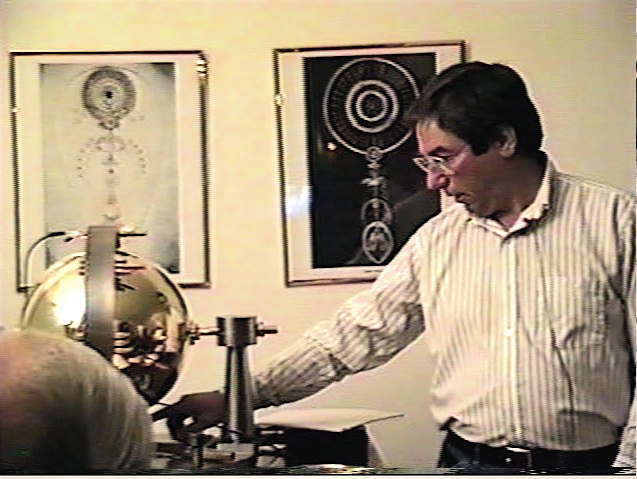 |
| In court? Need assistance? Jurisdictionary |
 |
| Your Own Credit Repair Business |
|
Topic: Keely Information Section: Levitating Gyroscopes Table of Contents to this Topic |
|
Levitating Gyroscopes John Ernest Worrell Keely, 1894 "A small instrument, having three gyroscopes as a principal part of its construction, is used to demonstrate the facts of aerial navigation. These gyroscopes are attached to a heavy, inert mass of metal, weighing about one ton. The other part of the apparatus consists of tubes, enclosed in as small a space as possible, being clustered in a circle. These tubes, represent certain chords, which were coincident to the streams of force acting upon the planet, focalizing and defocalizing upon its neutral center. The action upon the molecular structure of the mass lifted was based upon the fact that each molecule in the mass possessed a north and south pole, - more strictly speaking, a positive and negative pole, - situated through the center, formed by the three atoms which compose it. No matter which way the mass of metal is turned, the poles of the molecule point undeviatingly to the polar center of the earth, acting almost exactly as the dip-needle when uninfluenced by extraneous conditions, electrical and otherwise. The rotation of the discs of the gyroscopes produces an action upon the molecules of the mass to be lifted, reversing their poles, causing repulsion from the earth in the same way as like poles of a magnet repel each other. This repulsion can be diminished and increased according as the mechanical conditions are operated. By operating the three discs, starting them at full speed, then touching two of them, so as to bring them, according to the tone they represented by their rotation, to a certain vibratory ratio, the weight then slowly sways from side to side leaves the floor, rising several feet in the air, remaining in that position, and as the discs gradually decrease their speed of rotation the weight sinks to the floor, settling down as lightly as thistle-down. Where one molecule can be lifted, there need be no limit as to the number in a structure that may be operated upon as easily as one. The vessel in contemplation, the aerial navigator, will be over two hundred feet long, over sixty feet in diameter, tapering at both ends to a point, made of polished steel, and will be capable of being driven under the power of depolar repulsion, at the rate of three hundred miles an hour. It can be far more easily controlled than any instrument now in use for any phase of transit. Another very remarkable feature connected with this system of aerial navigation, is that the vessel is not buoyed up or floated in the air through the medium of the air, so that if there were no atmosphere it would float just as readily; hence, under mechanical conditions most certainly capable of production, involving massive strength of resistance to interstellar vacuity this can be made capable of navigating even the remote depth of space, positions between planets where polarity changes being controlled by other adjuncts of concentration for that purpose. Safely enclosed within this structure, a man possessing the chemical knowledge these new laws give, with sufficient supply of material from which to make oxygen, by the enormously increased rate of speed attained by such navigator where atmospheric friction is avoided, the time occupied in traveling from one planet to another would be amazingly brief, and one can travel to other planets in this system of worlds as easily as the same ship could navigate the depths of the ocean. The great obstacle hitherto preventing the solution of this problem has been the strength of structure needed under conditions above presented. With this knowledge of matter, the size of structure is unimportant; the heaviest can be as easily controlled as the lightest." From Dashed Against the Rocks, by William Colville, 1894. |
| See Also: |
 |
